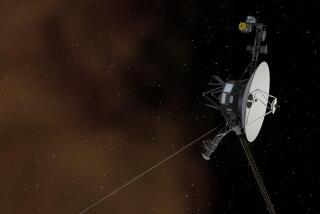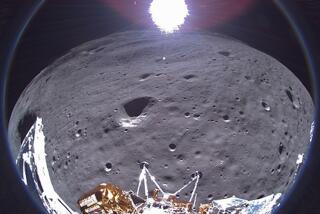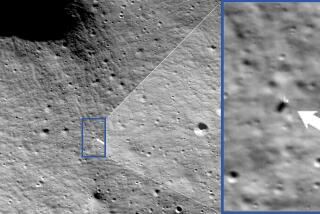Rover Has Spirit but Not Enough Memory
- Share via
The malfunctioning of NASA’s Spirit rover on Mars was apparently caused by a memory shortage that sent the craft into an endless cycle of computer reboots, officials at Pasadena’s Jet Propulsion Laboratory said Monday.
Like an underpowered home PC, Spirit does not have enough random access memory, or RAM, to juggle the massive number of data files it accumulated during its flight to Mars.
The rover’s on-board computer has 256 megabytes of flash memory, which is like the memory cards in a digital camera.
This memory is retained when the computer shuts down. It also has 128 megabytes of RAM, used for temporarily storing data and managing the operations of the computer. The RAM is erased when the computer shuts down.
Although a home computer would simply run very slowly, the file management problem in Spirit caused it to repeatedly reboot, a process it carried out more than 130 times before mission controllers regained control of the craft overnight Friday.
To free memory space, the JPL team is doing what a home computer user would do: deleting files, beginning with the hundreds accumulated during the craft’s seven-month journey to the Red Planet, said mission manager Jennifer Trosper. Spirit landed on Mars on Jan. 3.
“The patient is in rehab and we are nursing her back to health,” she said.
Meanwhile, on the other side of Mars, the rover Opportunity continued the process of establishing itself on the Martian surface, unlimbering its mast, taking some pictures for the folks back home and orienting itself in its surroundings. Opportunity, which is identical to Spirit, landed Saturday on Mars at a spot known as Meridiani Planum.
“We couldn’t be more happy with what we are seeing at this landing site,” said Jim Bell of Cornell University, who developed the high-definition cameras used by the rovers.
“This is a pretty spectacular landing site.”
A new image shows a reddish, chocolate-brown soil with patches of lighter red and an outcrop of rock that Bell called “the Holy Grail of geologists.”
One of the first tasks of the rover, he said, will be to find out why the soil gets brighter when it is compressed, as it was when the air-bags-encased lander bounced across the surface.
Opportunity is in perfect health, including the Mossbauer spectrometer that had displayed problems when it was tested during the flight to Mars, according to principal investigator Steve Squyres of Cornell.
The Mossbauer spectrometer on Spirit displayed the same problems in transit, but it too was fine once it reached the surface. The device is designed to identify various iron-bearing minerals.
“They have healed themselves,” Squyres said.
He said that the problems were probably caused by the lack of gravity and the spinning of the spacecraft during the voyage. The instruments were “never designed to work in a vacuum or zero [gravity],” he said.
Trosper said that the rover team will probably delete all the cruise data files from Opportunity in the near future to avoid a repeat of the problem encountered with Spirit.
The news was not so good in England, where British scientists have apparently conceded that their Beagle 2 lander, which was to have reached the Martian surface Christmas Eve, is defunct.
The team has not been able to contact the lander since then. “Under these circumstances, we have to begin to accept that if Beagle 2 is on the Martian surface, it is not active,” said Colin Pillinger, principal investigator for the mission.
The team will make one more attempt, sending the lander a message to shut down and reboot its computer. “It’s a pretty drastic action,” Pillinger said. “That is why we have left it to the last minute.”
Pillinger added: “Now is not the time to grieve.... We hope very much we will be back with Beagle 2 pups.”
More to Read
Sign up for Essential California
The most important California stories and recommendations in your inbox every morning.
You may occasionally receive promotional content from the Los Angeles Times.










